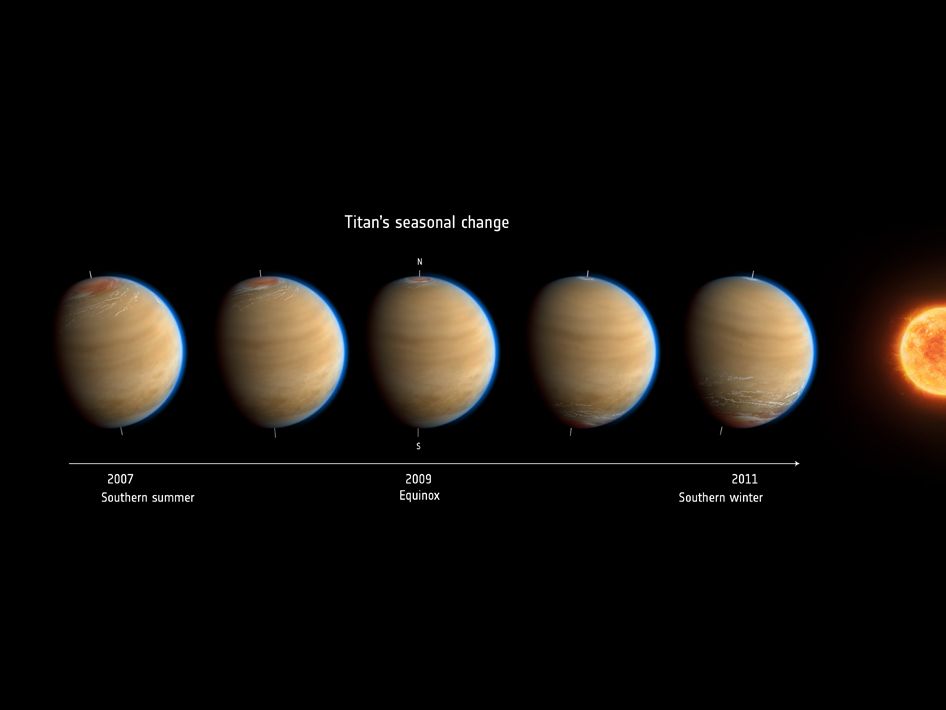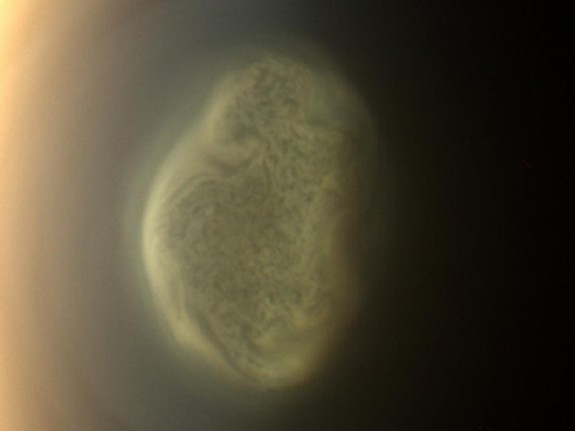Data from NASA’s Cassini mission to Saturn is giving space scientists a clearer picture of seasonal changes on Titan, Saturn’s large moon. The image below is an artist’s impression, showing seasonal change in Titan’s atmosphere during and after Titan’s 2009 equinox. An equinox for Earth or any planet or moon occurs when the sun appears over that world’s equator at local noon. It’s a seasonal marker, in this case a time when both hemispheres of a world are receiving more or less equal heating from the sun. Scientists say the change in seasons on Titan before and after this equinox involved a wholesale reversal, at unexpected altitudes in the circulation of Titan’s atmosphere.

The Cassini spacecraft arrived at Saturn in 2004. During the first years of its exploration, it was winter in Titan’s northern hemisphere. The north pole of Titan was seen to have a “hood” of dense gaseous haze (shown in white in the image above, shown larger in the image below), and a high-altitude “hot spot” (show in red, above). This haze was associated with a vortex above Titan’s north pole.
Click here for a movie of Titan’s north pole vortex in motion
And then the season changed. After Titan’s 2009 equinox, the moon’s north pole began tilting more in the direction towards the sun. Spring was arriving in Titan’s northern hemisphere. Meanwhile, the moon’s southern hemisphere was tilting away from the sun and moving into autumn.

After Titan’s equinox and until 2011, there was still a significant build up of trace gases over the north pole, even though the north pole vortex, and the observed hot spot, had almost disappeared.
Meanwhile, similar features began developing at the south pole, for example, a south pole vortex, which are still present today.
In a press release, Cassini scientists said these changes indicate:
… a large-scale reversal in the single pole-to-pole atmospheric circulation cell of Titan immediately after equinox, with an upwelling of gases in the summer hemisphere and a corresponding downwelling in the winter hemisphere.

Mike Flasar at NASA’s Goddard Space Flight Center in Greenbelt, Maryland added:
Next, we would expect to see the vortex over the south pole build up. As that happens, one question is whether the south winter pole will be the identical twin of the north winter pole, or will it have a distinct personality? The most important thing is to be able to keep watching as these changes happen.
And watch they will, as long as the wonderful Cassini spacecraft continues sending back its data.
Bottom line: Who would have imagined a few decades ago that we’d be able to watch the seasons change on Saturn’s large moon Titan. And yet the Cassini spacecraft, which has been orbiting in and around the Saturnian system since 2004, lets us do just that. Scientists have seen what they’re calling a wholesale reversal in the atmosphere of Titan, from 2004 to now.
Read more about the reversal in Titan’s atmospheric circulation here.











